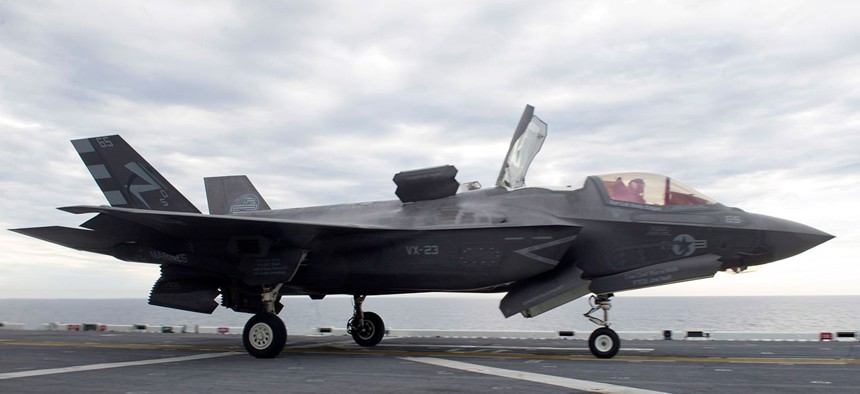Pentagon Tester: F-35 Program Rushing Tests, Delays Still Likely
The JSF's latest report card finds 276 deficiencies in combat performance.
The F-35 program office’s rush to make an August test deadline will increase risks yet still leave the effort well behind schedule, the Pentagon’s top weapons tester said in a report released today.
That verdict, from the Office of Operational Testing and Evaluation, came as no surprise, though it is another black eye for Donald Trump’s least favorite combat jet.
The report did note some progress, such as the completion of important ship-integration tests and steps toward fixing a dangerous ejection seat.
However, most of chief tester Michael Gilmore’s report focuses on what still needs to be done. And it’s plenty. OTE has noted some “276 deficiencies in combat performance” as part of the most recent rollout of improvements. The Pentagon and Lockheed Martin, the company that makes the planes, have been working on them, but their plans for the next block of improvements, Block 3FR6, will address fewer than half of the deficiencies.
As for Block 3F, the most recent set of upgrades, the report notes “significant, well-documented deficiencies resulting in overall ineffective operational performance...hundreds of which will not be adequately addressed with fixes and corrections verified with flight testing within the system [development and demonstration phase].”
The report also concludes that “the current schedule-driven program plans to close out [for development and demonstration] testing in 2017 do not include enough time to fix these key deficiencies, nor time to verify corrections in flight test.”
The risk is that the program, out of a sense of urgency, may look to verify fixes in the lab rather than in actual flight tests. This is, a huge safety concern “because the labs proved to not always be representative of the actual aircraft for detecting problems or verifying fixes for stability problems.”
The most important items on the to-do list: fix the plane’s 25mm gun and its analytics and diagnostic software.
While the office did complete ground firing tests for the gun on all the variants of the F-35, only the A model has completed initial flight testing with the notoriously troublesome weapon. Testing has revealed problems in display that the pilot sees in the helmet (when trying to target the gun). The report suggests a “high likelihood” of additional discoveries about the gun as more testing takes place, causing further delays, according to the report.
The biggest problem by far remains the complex Autonomic Logistics Information System, or ALIS, which monitors the health of the plane’s parts and tells operators and maintainers what’s happening with the jet. It’s probably the most infamous piece of software in the military, having earned a short spot on “60 Minutes” in 2014. The plane does not need it to fly, but does need it for maintenance.
To accelerate the roll-out of improvements to ALIS, the program office has begun delivering smaller software upgrades, not just big block upgrades.
“Service packs are developed, tested and fielded on a much quicker timeline than our larger increments of ALIS,” Lt. Gen. Chris Bogdan testified in March.
The Air Force deadline for conduct important operational tests (also called initial operational test and evaluation, or IOT&E) has slipped to fall 2017. The report suggests it could slide further.




